Future Changes in Global Precipitation Projected by the Atmospheric Model MRI-AGCM3.2H with a 60-km Size
Abstract
:1. Introduction
2. Models and Experimental Design
2.1. The Global Atmospheric Model
2.2. Sea Surface Temperature and Sea Ice
2.3. Other External Forcings
3. Present-Day Climate
3.1. Observation for Model Verification
3.2. Global Distribution of Precipitation
3.3. Taylor Diagram
3.4. Extreme Precipitation Events
4. Future Climate
4.1. Changes in Annual Average Precipitation
4.2. Extreme Precipitation Events
4.3. Which Influences Precipitation Change, the Cumulus Convection Scheme or SST?
4.4. Precipitation Efficiency
5. Conclusions
Supplementary Materials
Acknowledgments
Conflicts of Interest
References
- Cubasch, U.; Wuebbles, D.; Chen, D.; Facchini, M.C.; Frame, D.; Mahowald, N.; Winther, J.-G. Introduction. In Climate Change 2013: The Physical Science Basis; Contribution of Working Group I to the Fifth Assessment Report of the Intergovernmental Panel on Climate Change; Stocker, T.F., Qin, D., Plattner, G.-K., Tignor, M., Allen, S.K., Boschung, J., Nauels, A., Xia, Y., Bex, V., Midgley, P.M., Eds.; Cambridge University Press: Cambridge, UK; New York, NY, USA, 2013. [Google Scholar]
- Shiogama, H.; Watanabe, M.; Ogura, T.; Yokohata, T.; Kimoto, M. Multi-parameter multi-physics ensemble (MPMPE): A new approach exploring the uncertainties of climate sensitivity. Atmos. Sci. Lett. 2014, 15, 97–102. [Google Scholar] [CrossRef]
- Kusunoki, S.; Yoshimura, J.; Yoshimura, H.; Noda, A.; Oouchi, K.; Mizuta, R. Change of Baiu rain band in global warming projection by an atmospheric general circulation model with a 20-km grid size. J. Meteorol. Soc. Jpn. 2006, 84, 581–611. [Google Scholar] [CrossRef]
- Kitoh, A.; Kusunoki, S. East Asian summer monsoon simulation by a 20-km mesh AGCM. Clim. Dyn. 2007, 31, 389–401. [Google Scholar] [CrossRef]
- Kusunoki, S. Is the global atmospheric model MRI-AGCM3.2 better than the CMIP5 atmospheric models in simulating precipitation over East Asia? Clim. Dyn. 2016, 1–22. [Google Scholar] [CrossRef]
- Kusunoki, S.; Mizuta, R. Future Changes in the Baiu Rain Band Projected by a 20-km Mesh Global Atmospheric Model: Sea Surface Temperature Dependence. Sci. Online Lett. Atmos. 2008, 4, 85–88. [Google Scholar] [CrossRef]
- Kusunoki, S.; Mizuta, R.; Matsueda, M. Future changes in the East Asian rain band projected by global atmospheric models with 20-km and 60-km grid size. Clim. Dyn. 2011, 37, 2481–2493. [Google Scholar] [CrossRef]
- Kusunoki, S.; Mizuta, R. Comparison of near future (2015–2039) changes in the East Asian rain band with future (2075–2099) changes projected by global atmospheric models with 20-km and 60-km grid size. Sci. Online Lett. Atmos. 2012, 8, 73–76. [Google Scholar] [CrossRef]
- Endo, H.; Kitoh, A.; Ose, T.; Mizuta, R.; Kusunoki, S. Future changes and uncertainties in Asian precipitation simulated by multiphysics and multi-sea surface temperature ensemble experiments with high-resolution Meteorological Research Institute atmospheric general circulation models (MRI-AGCMs). J. Geophys. Res. 2012, 117, D16118. [Google Scholar] [CrossRef]
- Kusunoki, S.; Mizuta, R. Changes in precipitation intensity over East Asia during the 20th and 21st centuries simulated by a global atmospheric model with a 60 km grid size. J. Geophys. Res. Atmos. 2013, 118, 11007–11016. [Google Scholar] [CrossRef]
- Kitoh, A.; Endo, H. Changes in precipitation extremes projected by a 20-km mesh global atmospheric model. Weather Clim. Extremes 2016, 11, 41–52. [Google Scholar] [CrossRef]
- Mizuta, R.; Murata, A.; Ishii, M.; Shiogama, H.; Hibino, K.; Mori, N.; Arakawa, O.; Imada, Y.; Yoshida, K.; Aoyagi, T.; et al. Over 5000 years of ensemble future climate simulations by 60 km global and 20 km regional atmospheric models. Bull. Am. Meteorol. Soc. 2016. [Google Scholar] [CrossRef]
- Endo, H.; Kitoh, A.; Mizuta, R.; Ishii, M. Future changes in precipitation extremes in East Asia and their uncertainty based on large ensemble simulations with a high resolution AGCM. Sci. Online Lett. Atmos. 2017, 13, 7–12. [Google Scholar] [CrossRef]
- Kusunoki, S. Future changes in precipitation over East Asia projected by the global atmospheric model MRI-AGCM3.2. Clim. Dyn. 2017, 1–17. [Google Scholar] [CrossRef]
- Bengtsson, L.; Hodges, K.I.; Keenlyside, N. Will extratropical storms intensify in a warmer climate? J. Clim. 2009, 22, 2276–2301. [Google Scholar] [CrossRef]
- Douville, H. Impact of regional SST anomalies on the Indian Monsoon response to global waming in the CNRM climate model. J. Clim. 2005, 19, 2008–2024. [Google Scholar] [CrossRef]
- Hasegawa, A.; Emori, S. Effect of air-sea coupling in the assessment of CO2-induced intensification of tropical cyclone activity. Geophys. Res. Lett. 2007, 34, L05701. [Google Scholar] [CrossRef]
- Ogata, T.; Mizuta, R.; Adachi, Y.; Murakami, H.; Ose, T. Effect of air-sea coupling on the frequency distribution of intense tropical cyclones over the northwestern Pacific. Geophys. Res. Lett. 2015, 42, 10415–10421. [Google Scholar] [CrossRef]
- Ma, J.; Xie, S.-P. Regional Patterns of Sea Surface Temperature Change: A Source of Uncertainty in Future Projections of Precipitation and Atmospheric Circulation. J. Clim. 2013, 26, 2482–2501. [Google Scholar] [CrossRef]
- Held, I.M.; Soden, B.J. Robust Responses of the Hydrological Cycle to Global Warming. J. Clim. 2006, 19, 5686–5699. [Google Scholar] [CrossRef]
- Vecchi, G.A.; Soden, B.J. Global warming and the weakening of the tropical circulation. J. Clim. 2007, 20, 4316–4340. [Google Scholar] [CrossRef]
- Mizuta, R.; Yoshimura, H.; Murakami, H.; Matsueda, M.; Endo, H.; Ose, T.; Kamiguchi, K.; Hosaka, M.; Sugi, M.; Yukimoto, S.; et al. Climate simulations using MRI-AGCM3.2 with 20-km grid. J. Meteorol. Soc. Jpn. 2012, 90A, 233–258. [Google Scholar] [CrossRef]
- Yoshimura, H.; Mizuta, R.; Murakami, H. A spectral cumulus parameterization scheme interpolating between two convective updrafts with semi-lagrangian calculation of transport by compensatory subsidence. Mon. Weather Rev. 2015, 143, 597–621. [Google Scholar] [CrossRef]
- Tiedtke, M. A comprehensive mass flux scheme for cumulus parameterization in large-scale models. Mon. Weather Rev. 1989, 117, 1779–1800. [Google Scholar] [CrossRef]
- Randall, D.A.; Pan, D.M. Implementation of the Arakawa-Schubert cumulus parameterization with a prognostic closure. In The Representation of Cumulus Convection in Numerical Models; American Meteorological Society: Boston, MA, USA, 1993; Volume 24, Chapter 11, No. 46; pp. 137–147. [Google Scholar]
- Kain, J.S.; Fritsch, J.M. A one-dimensional entraining/detraining plume model and its application in convective parameterization. J. Atmos. Sci. 1990, 47, 2784–2802. [Google Scholar] [CrossRef]
- Yukimoto, S.; Yoshimura, H.; Hosaka, M.; Sakami, T.; Tsujino, H.; Hirabara, M.; Tanaka, T.; Deushi, M.; Obata, A.; Nakano, H.; et al. Meteorological Research Institute—Earth System Model Version 1 (MRI-ESM1)—Model Description; Technical Reports of the Meteorological Research Institute; Meteorological Research Institute: Tsukuba, Japan, 2011; Volume 64, p. 88. [Google Scholar]
- Rayner, N.A.; Parker, D.E.; Horton, E.B.; Folland, C.K.; Alexander, L.V.; Rowell, D.P.; Kent, E.C.; Kaplan, A. Global analyses of sea surface temperature, sea ice, and night marine air temperature since the late nineteenth century. J. Geophys. Res. 2003, 108, 4407–4437. [Google Scholar] [CrossRef]
- Collins, M.; Knutti, R.; Arblaster, J.; Dufresne, J.-L.; Fichefet, T.; Friedlingstein, P.; Gao, X.; Gutowski, W.J.; Johns, T.; Krinner, G.; et al. Section 12; Long-term Climate Change: Projections, Commitments and Irreversibility. In Climate Change 2013: The Physical Science Basis; Contribution of Working Group I to the Fifth Assessment Report of the Intergovernmental Panel on Climate Change; Stocker, T.F., Qin, D., Plattner, G.-K., Tignor, M., Allen, S.K., Boschung, J., Nauels, A., Xia, Y., Bex, V., Midgley, P.M., Eds.; Cambridge University Press: Cambridge, UK; New York, NY, USA, 2013. [Google Scholar]
- Mizuta, R.; Adachi, Y.; Yukimoto, S.; Kusunoki, S. Estimation of the Future Distribution of Sea Surface Temperature and Sea Ice Using the CMIP3 Multi-Model Ensemble Mean; Technical Reports of the Meteorological Research Institute; Meteorological Research Institute: Tsukuba, Japan, 2008; Volume 56, p. 28. [Google Scholar]
- Mizuta, R.; Arakawa, O.; Ose, T.; Kusunoki, S.; Endo, H.; Kitoh, A. Classification of CMIP5 future climate responses by the tropical sea surface temperature changes. SOLA 2014, 10, 167–171. [Google Scholar] [CrossRef]
- Intergovermental Panel on Climate Change (IPCC). Special Report on Emissions Scenarios: A Special Report of Working Group III of the Intergovernmental Panel on Climate Change; Nakicenovic, N., Alcamo, J., Davis, G., de Vries, B., Fenhann, J., Gaffin, S., Gregory, K., Grübler, A., Jung, T.Y., Kram, T., et al., Eds.; Cambridge University Press: Cambridge, UK, 2000; p. 599. [Google Scholar]
- Shibata, K.; Deushi, M.; Sekiyama, T.T.; Yoshimura, H. Development of an MRI chemical transport model for the study of stratospheric chemistry. Pap. Meteorol. Geophys. 2004, 55, 75–119. [Google Scholar] [CrossRef]
- Huffman, G.J.; Adler, R.F.; Morrissey, M.M.; Bolvin, D.T.; Curtis, S.; Joyce, R.; McGavock, B.; Susskind, J. Global precipitation at one-degree daily resolution from multisatellite observations. J. Hydrometeorol. 2001, 2, 36–50. [Google Scholar] [CrossRef]
- Sperber, K.R.; Annamalai, H.; Kang, I.S.; Kitoh, A.; Moise, A.; Turner, A.G.; Wang, B.; Zhou, T. The Asian summer monsoon: An intercomparison of CMIP5 vs. CMIP3 simulations of the late 20th century. Clim. Dyn. 2013, 41, 2711–2744. [Google Scholar] [CrossRef]
- Adler, R.F.; Huffman, G.J.; Chang, A.; Ferrano, R.; Xie, P.P.; Janowiak, J.; Rudolf, B.; Schneider, U.; Curtis, S.; Bolvin, D.; et al. The Version-2 Global Precipitation Climatology Preject (GPCP) monthly precipitation analysis (1979–Present). J. Hydrometeorol. 2003, 4, 1147–1167. [Google Scholar] [CrossRef]
- Xie, P.; Arkin, P. Global precipitation: A 17-year monthly analysis based on gauge observations, satellite estimates and numerical model outputs. Bull. Am. Meteorol. Soc. 1997, 78, 2539–2558. [Google Scholar] [CrossRef]
- Huffman, G.J.; Adler, R.F.; Bolvin, D.T.; Gu, G.; Nelkin, E.J.; Bowman, K.P.; Hong, Y.; Stocker, E.F.; Wolff, D.B. The TRMM Multisatellite Precipitation Analysis (TMPA): Quasi-global, multiyear, combined-sensor precipitation estimates at fine scales. J. Hydrometeorol. 2007, 8, 38–55. [Google Scholar] [CrossRef]
- Minobe, S.; Kuwano-Yoshida, A.; Komori, N.; Xie, S.-P.; Small, R.J. Influence of the Gulf Stream on the troposphere. Nature 2008, 452, 206–209. [Google Scholar] [CrossRef] [PubMed]
- Taylor, K.E. Summarizing multiple aspects of model performance in a single diagram. J. Geophys. Res. 2001, 106, 7183–7192. [Google Scholar] [CrossRef]
- Lambert, S.J.; Boer, G.J. CMIP1 evaluation and intercomparison of coupled climate models. Clim. Dyn. 2001, 17, 83–106. [Google Scholar] [CrossRef]
- Gleckler, P.J.; Taylor, K.E.; Doutriaux, C. Performance metrics for climate models. J. Geophys. Res. 2008, 113, D06104. [Google Scholar] [CrossRef]
- Reichler, T.; Kim, J. How well do coupled models simulate today’s climate? Bull. Am. Meteorol. Soc. 2008, 89, 303–311. [Google Scholar] [CrossRef]
- Frich, P.; Alexander, L.V.; Della-Marta, P.; Gleason, B.; Haylock, M.; Klein Tank, A.M.G.; Peterson, T. Observed coherent changes in climatic extremes during the second half of the twentieth century. Clim. Res. 2002, 19, 193–212. [Google Scholar] [CrossRef]
- Dai, A. Precipitation characteristics in eighteen coupled climate models. J. Clim. 2006, 19, 4605–4630. [Google Scholar] [CrossRef]
- Intergovernmental Panel on Climate Change (IPCC). Climate Change 2013: The Physical Science Basis; Contribution of Working Group I to the Fifth Assessment Report of the Intergovernmental Panel on Climate Change; Stocker, T.F., Qin, D., Plattner, G.K., Tignor, M., Allen, S.K., Boschung, J., Nauels, A., Xia, Y., Bex, V., Midgley, P.M., Eds.; Cambridge University Press: Cambridge, UK; New York, NY, USA, 2013; p. 1535. [Google Scholar]
- Hennessy, K.J.; Gregory, J.M.; Mitchell, J.F.B. Changes in daily precipitation under enhanced greenhouse conditions. Clim. Dyn. 1997, 13, 667–680. [Google Scholar] [CrossRef]
- Kharin, V.V.; Zwiers, F.W. Changes in the extremes in an ensemble of transient climate simulations with a coupled atmosphere-ocean GCM. J. Clim. 2000, 13, 3760–3788. [Google Scholar] [CrossRef]
- Wehner, M.F. Predicted 21st century changes in seasonal extreme precipitation events in the Parallel Climate Model. J. Clim. 2004, 17, 4281–4290. [Google Scholar] [CrossRef]
- Emori, S.; Brown, S.J. Dynamic and thermodynamic changes in mean and extreme precipitation under changed climate. Geophys. Res. Lett. 2005, 32, L17706. [Google Scholar] [CrossRef]
- Pall, P.; Allen, M.R.; Stone, D.A. Testing the Clausius-Clapeyron constraint on changes in extreme precipitation under CO2 warming. Clim. Dyn. 2007, 28, 351–363. [Google Scholar] [CrossRef]
- Storch, H.V.; Zwiers, F.W. Section 9 Analysis of Variance. In Statistical Analysis in Climate Research; Storch, H.V., Zwiers, F.W., Eds.; Cambridge University Press: Cambridge, UK, 1999; pp. 171–192. [Google Scholar]
- Deser, C.; Knutti, R.; Solomon, S.; Phillips, A.S. Communication of the role of natural variability in future North American climate. Nat. Clim. Chang. 2012, 2, 775–779. [Google Scholar] [CrossRef]
- Intergovernmental Panel on Climate Change (IPCC). Climate Change 2007: The Physical Science Basis; Contribution of Working Group I to the Fourth Assessment Report of the Intergovernmental Panel on Climate Change; Solomon, S., Qin, D., Manning, M., Chen, Z., Marquis, M., Averyt, K.B., Tignor, M., Miller, H.L., Eds.; Cambridge University Press: Cambridge, UK; New York, NY, USA, 2007; p. 996. [Google Scholar]
- Intergovernmental Panel on Climate Change (IPCC). Climate Change 2001: The Scientific Basis; Contribution of Working Group I to the Third Assessment Report of the Intergovernmental Panel on Climate Change; Houghton, J.T., Ding, Y., Griggs, D.J., Noguer, M., van der Linden, P.J., Dai, X., Maskell, K., Johnson, C.A., Eds.; Cambridge University Press: Cambridge, UK; New York, NY, USA, 2001; p. 881. [Google Scholar]
- Hegerl, G.C.; Zwiers, F.W.; Stott, P.A.; Kharin, V.V. Detectability of anthropogenic changes in annual temperature and precipitation extremes. J. Clim. 2004, 17, 3683–3700. [Google Scholar] [CrossRef]
- Kusunoki, S.; Mizuta, R.; Hosaka, M. Future changes in precipitation intensity over the Arctic projected by a global atmospheric model with a 60-km grid size. Polar Sci. 2015, 9, 277–292. [Google Scholar] [CrossRef]
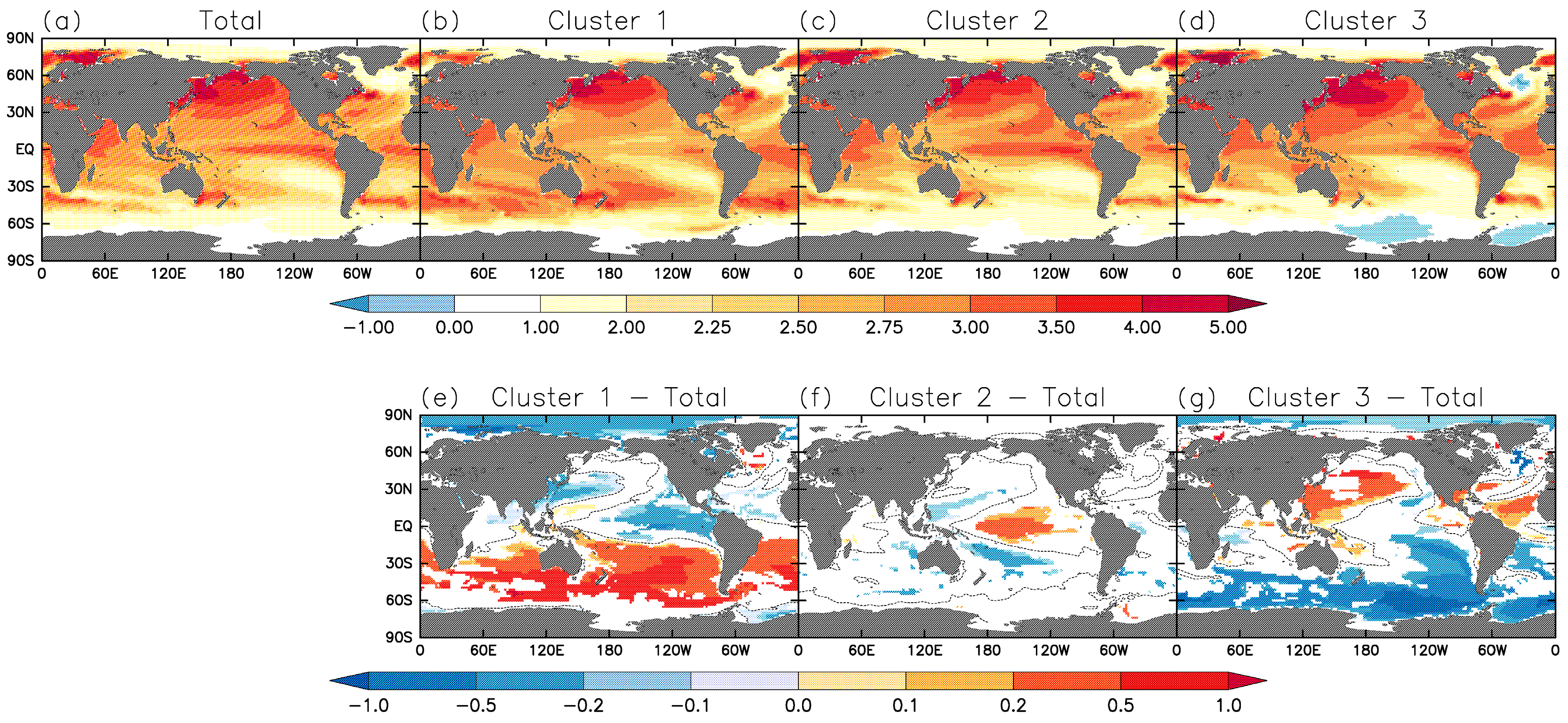
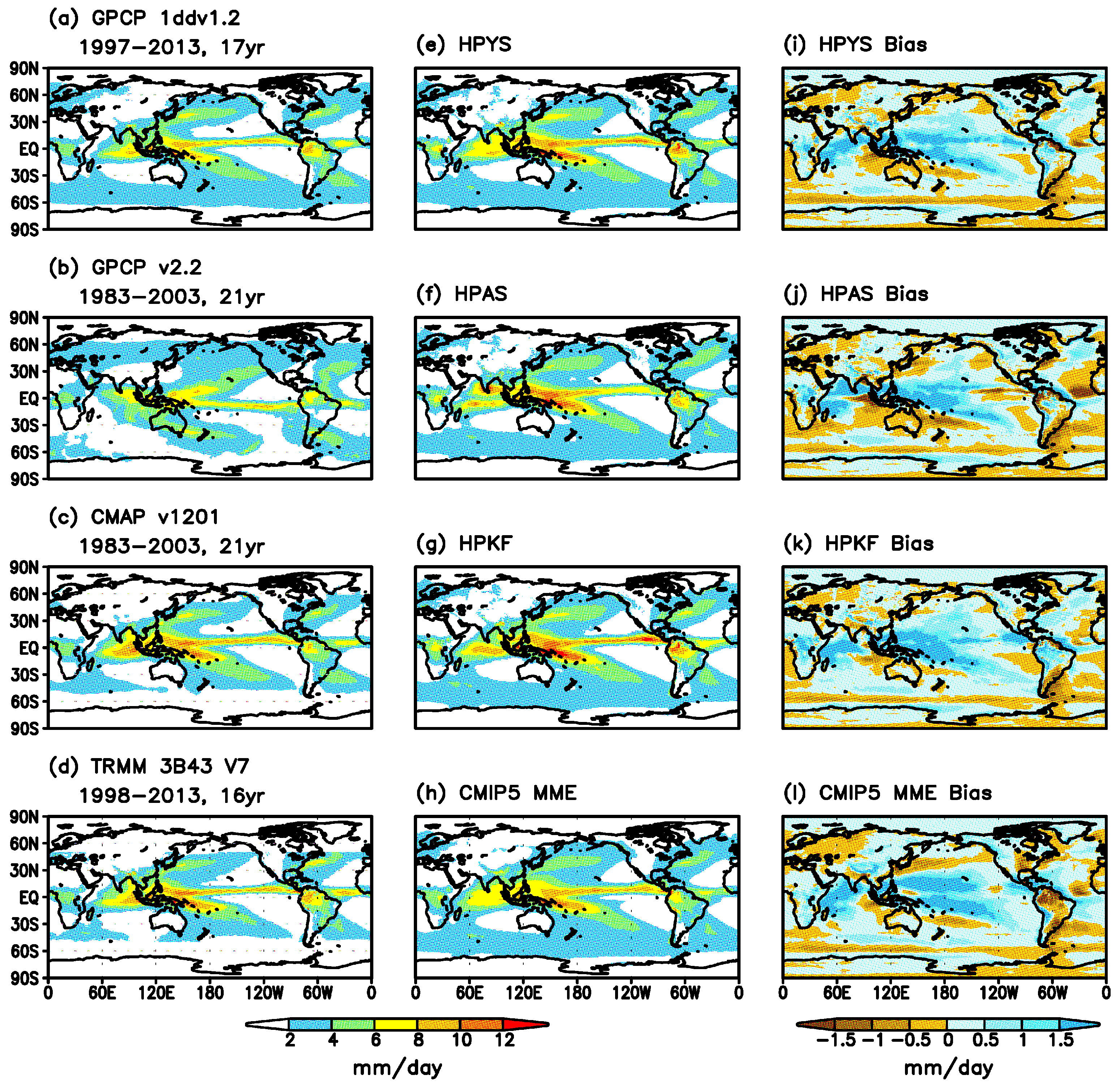

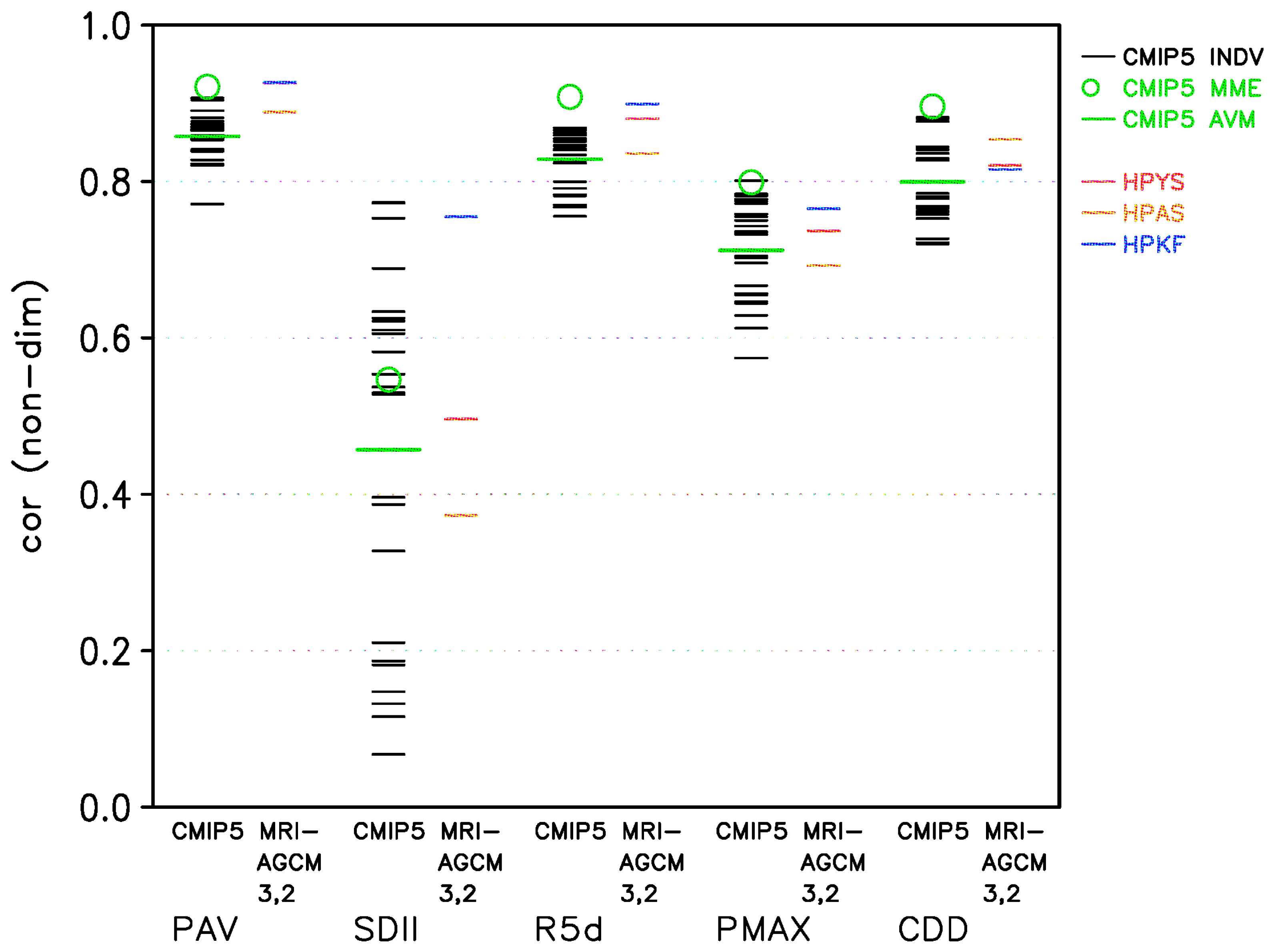
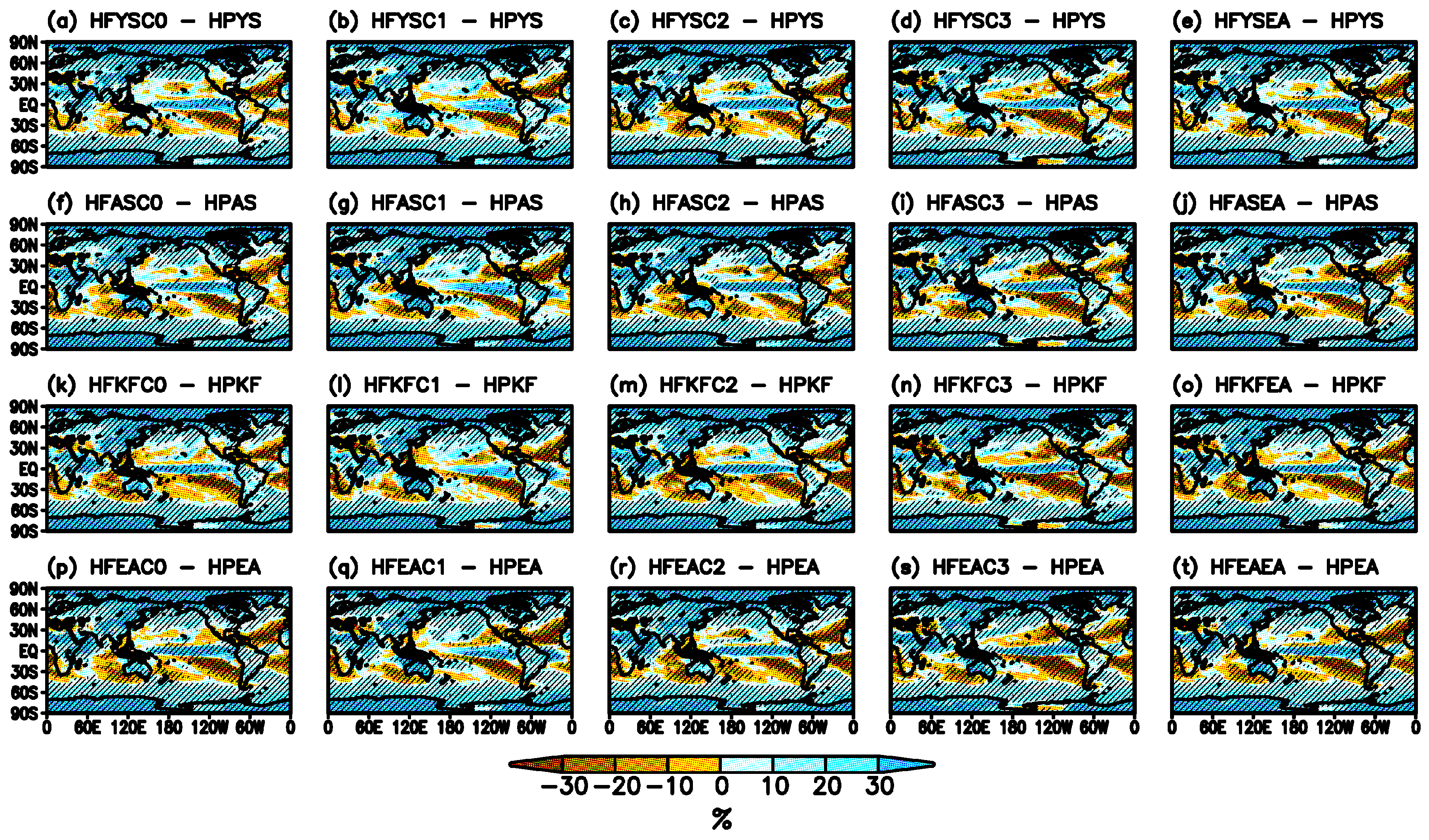
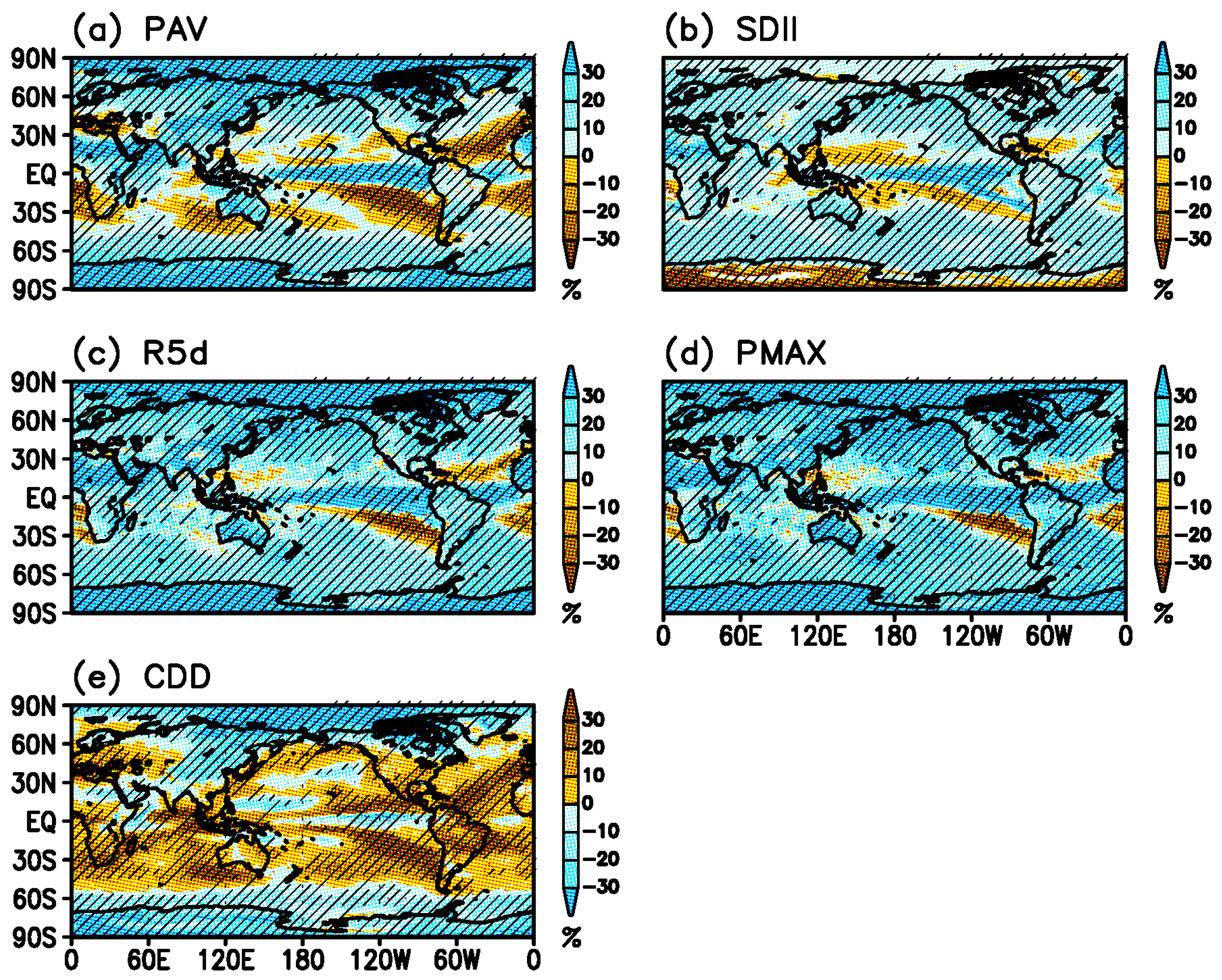


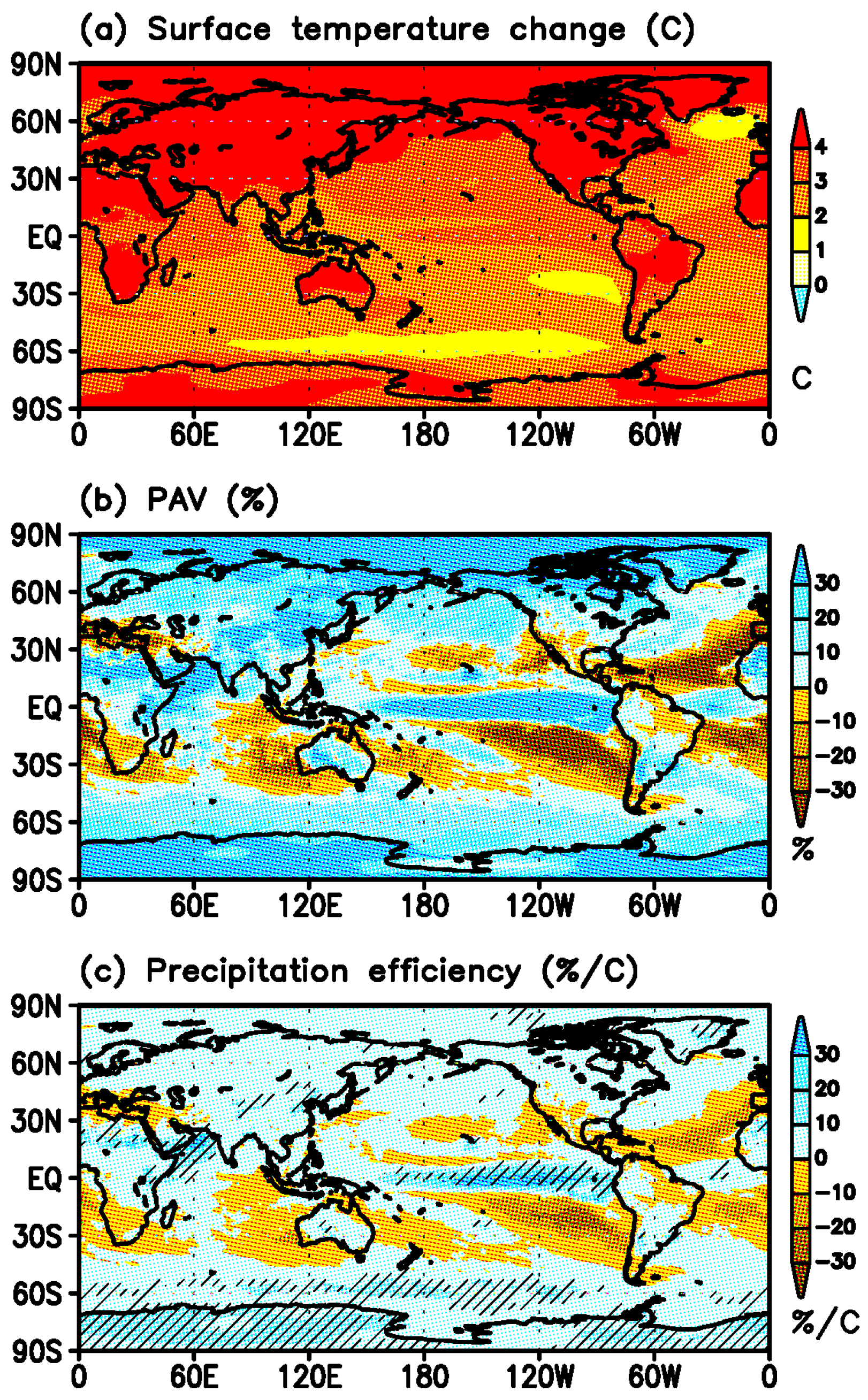
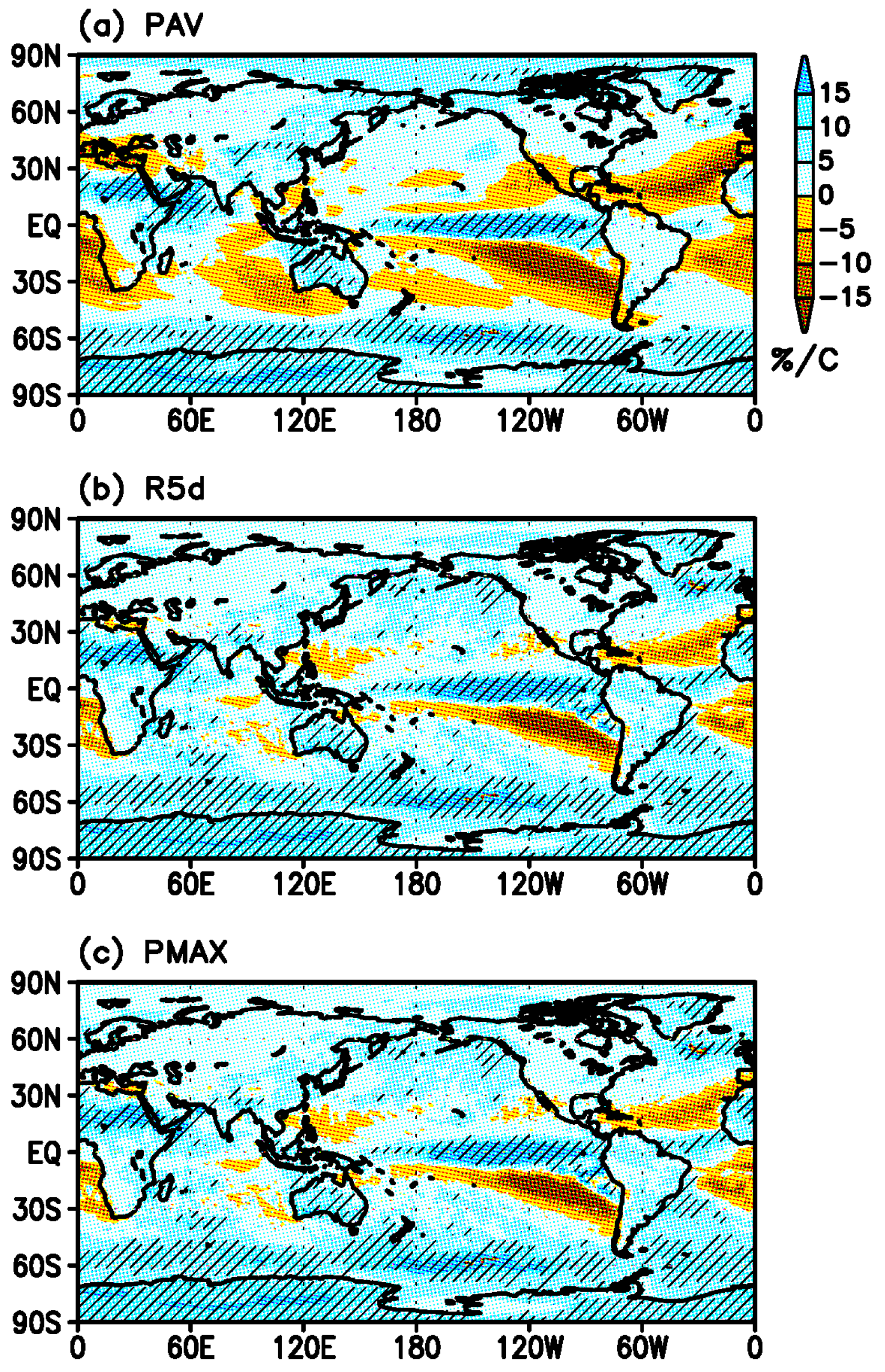

| Present-Day Climate: 1983–2003, 21 Years | ||||
|---|---|---|---|---|
| Cumulus Convection a | Sea Surface Temperature (SST): Observation by the HadISST1 [28] | |||
| YS | HPYS | |||
| AS | HPAS | |||
| KF | HPKF | |||
| Future Climate: 2079–2099, 21 years | ||||
| Cumulus Convection a | Sea surface Temperature (SST): Projections by the CMIP5 AOGCMs for the Emission Scenario RCP8.5 | |||
| Cluster 0 MME | Cluster 1 | Cluster 2 | Cluster 3 | |
| YS | HFYSC0 | HFYSC1 | HFYSC2 | HFYSC3 |
| AS | HFASC0 | HFASC1 | HFASC2 | HFASC3 |
| KF | HFKFC0 | HFKFC1 | HFKFC2 | HFKFC3 |
| Name | Time Resolution | Spatial Resolution | Period | Region | Reference |
|---|---|---|---|---|---|
| GPCP 1ddv1.2 | Day | 1.0 deg | 1997–2013, 17 years | Global | [34] |
| GPCP 1ddv1.2 | Month | 1.0 deg | 1997–2013, 17 years | Global | [34] |
| GPCP v2.2 | Month | 2.5 deg | 1981–2000, 20 years | Global | [36] |
| CMAP v1201 | Month | 2.5 deg | 1981–2000, 20 years | Global | [37] |
| TRMM 3B43 | Month | 0.25 deg | 1998–2013, 16 years | 50° S–50° N | [38] |
| Index | Name | Definition | Unit |
|---|---|---|---|
| PAV | Annual average precipitation | Annual average precipitation | mm day−1 |
| SDII | Simple daily precipitation intensity index | Total annual precipitation divided by the number of rainy days (precipitation ≥ 1 mm) | mm day−1 |
| R5d | Maximum 5-day precipitation total | Annual maximum of consecutive 5-day precipitation | mm |
| PMAX | Maximum 1-day precipitation total | Annual maximum of daily precipitation | mm |
| CDD | Consecutive dry days | Annual maximum number of consecutive dry days (precipitation < 1 mm) | day |
© 2017 by the author. Licensee MDPI, Basel, Switzerland. This article is an open access article distributed under the terms and conditions of the Creative Commons Attribution (CC BY) license (http://creativecommons.org/licenses/by/4.0/).
Share and Cite
Kusunoki, S. Future Changes in Global Precipitation Projected by the Atmospheric Model MRI-AGCM3.2H with a 60-km Size. Atmosphere 2017, 8, 93. https://doi.org/10.3390/atmos8050093
Kusunoki S. Future Changes in Global Precipitation Projected by the Atmospheric Model MRI-AGCM3.2H with a 60-km Size. Atmosphere. 2017; 8(5):93. https://doi.org/10.3390/atmos8050093
Chicago/Turabian StyleKusunoki, Shoji. 2017. "Future Changes in Global Precipitation Projected by the Atmospheric Model MRI-AGCM3.2H with a 60-km Size" Atmosphere 8, no. 5: 93. https://doi.org/10.3390/atmos8050093





